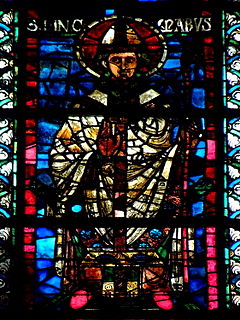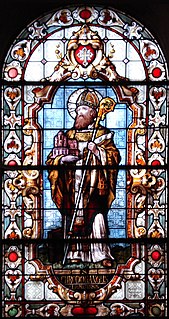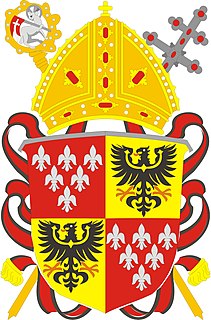
Year 823 (DCCCXXIII) was a common year starting on Thursday of the Julian calendar.
Pope John XIII was the bishop of Rome and ruler of the Papal States from 1 October 965 to his death. His pontificate was caught up in the continuing conflict between the Holy Roman emperor, Otto I, and the Roman nobility. After long and arduous negotiations, he succeeded in arranging a Byzantine marriage for Otto II, in an effort to legitimize the Ottonian claim to imperial dignity. He also established church hierarchy in Poland and Bohemia.
The Scottish Episcopal Church is the ecclesiastical province of the Anglican Communion in Scotland.
Sede vacante is a term for the state of a diocese while without a bishop. In the canon law of the Catholic Church, the term is used to refer to the vacancy of the bishop's or Pope's authority upon his death or resignation.

Hincmar, archbishop of Reims, was a Frankish jurist and theologian, as well as the friend, advisor and propagandist of Charles the Bald. He belonged to a noble family of northern Francia.

The Diocese of Växjö is one of the 13 dioceses or regional units of the Lutheran Church of Sweden. It was also a former Roman Catholic bishopric.

Chrodegang was the Frankish Bishop of Metz from 742 or 748 until his death. He served as chancellor for his kinsman, Charles Martel. Chrodegang is claimed to be a progenitor of the Frankish dynasty of the Robertians. He is recognized as a saint in the Catholic Church

Drogo, also known as Dreux or Drogon, was an illegitimate son of Frankish emperor Charlemagne by the concubine Regina.
Saint Chlodulf was bishop of Metz approximately from 657 to 697.

The Archdiocese of Wrocław is a Latin Church ecclesiastical territory or archdiocese of the Catholic Church centered in the city of Wrocław in Poland. From its founding as a bishopric in 1000 until 1821, it was under the Archbishopric of Gniezno in Greater Poland. From 1821 to 1930 it was subjected directly to the Apostolic See. Between 1821 and 1972 it was officially known as (Arch)Diocese of Breslau.

Camillus Paul Maes was a Belgian-born American prelate of the Catholic Church. He served as the third Bishop of Covington from 1885 until his death in 1915. He remains the longest-serving bishop of the diocese and, during his 30 years in office, he was most notably responsible for building the current Cathedral Basilica of the Assumption.
The appointment of bishops in the Catholic Church is a complicated process. Outgoing bishops, neighbouring bishops, the faithful, the apostolic nuncio, various members of the Roman Curia, and the pope all have a role in the selection. The exact process varies based upon a number of factors, including whether the bishop is from the Latin Church or one of the Eastern Catholic Churches, the geographic location of the diocese, what office the candidate is being chosen to fill, and whether the candidate has previously been ordained to the episcopate.

Pierre de Luxembourg was a French Catholic prelate who served as the Bishop of Metz, and as a cardinal of the Avignon Obedience from 1384 until his death.

The Diocese of Liège is a Latin Church ecclesiastical territory or diocese of the Catholic Church in Belgium. The diocese was erected in the 4th Century and presently covers the same territory as Belgium's Liège Province, but it was historically much larger. Currently, the diocese is a suffragan in the ecclesiastical province of the Archdiocese of Mechelen-Brussels. Its cathedra is found within St Paul's Cathedral in the episcopal see of Liège.

Henry Knox Sherrill was an Episcopal bishop. He was the 20th Presiding Bishop of the Episcopal Church from 1947 to 1958, having previously served as Bishop of Massachusetts (1930-1947).
The Diocese of Vincennes, the first Roman Catholic diocese in Indiana, was erected 6 May 1834 by Pope Gregory XVI. Its initial ecclesiastical jurisdiction encompassed Indiana as well as the eastern third of Illinois. In 1843 the Diocese of Chicago was erected from the Illinois portion of the diocese, and in 1857 Diocese of Fort Wayne was erected from the northern half of Indiana. The seat of the episcopal see was transferred from Vincennes, Indiana, to Indianapolis, and on 28 March 1898 it became the Diocese of Indianapolis. Pope Pius XII elevated the Indianapolis diocese to an archdiocese in 1944, and erected two new Indiana dioceses: the Diocese of Evansville and the Diocese of Lafayette. The Diocese of Gary, Indiana, was erected in 1956. The Evansville Diocese absorbed the city of Vincennes upon its creation.
Gundulf and its variants is a Germanic given name, from gund, "battle", and wulf, "wolf".
Adalbero I of Metz was an important member of the clergy during the middle years of the tenth century, serving as Bishop of Metz from 929 till 954.
The Diocese of Maastricht was a Roman Catholic jurisdiction in parts of present Netherlands and Belgium, which has been nominally revived as a Latin titular bishopric.